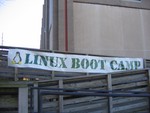Getting in Touch with my Inner Geek, Part 1
 The Central Indiana Linux Users Group (CINLUG) hosted a Linux Server Boot Camp. Two Saturdays, $60. That's a no-brainer!
The Central Indiana Linux Users Group (CINLUG) hosted a Linux Server Boot Camp. Two Saturdays, $60. That's a no-brainer!- Ten people showed up with computers, two with friends. There were three presenters. So...a good crowd. I sat beside Larry from Shelbyville, a technical and Linux hobbyist who runs it on a laptop for the basics (Internet, email, documents). All but two campers were NOT already associated with the Users Group, and all of them discovered the boot camp (as did I) by way of a search engine. I found it extremely interesting that only two other campers were close to me in age; most were 45+ -- an interesting and pleasant surprise!
- Each of us was given a three-ring binder which contained an agenda, printouts of each presentation (including step-by-step instructions for each phase of today's exercises), a references & links page, a "where to turn for help" page, a vim survival guide, and four CDs: Ubuntu 5.10 server edition, Ubuntu 5.10 "LIVE" boot CD (runs Linux in RAM disk and off the cd; never writes to the hard drive), Knoppix 4.0.2 boot CD, and TheOpenCD.org.
- After all the computers were wired up, we started by installing the server edition of the Ubuntu distribution, a derivative of Debian. Michael Schultheiss projected his display as we went and it was relatively simple -- of course, bypassing X Windows/GUI issues makes every Linux installation easier. (If you're interested in that type of thing, mark your calendar for March when they'll have a Linux Desktop boot camp.)
- While waiting for installation to finish, Michael talked a little about the Debian distribution and the Ubuntu distribution, the man who made it possible, future plans, always free, yadda yadda.
- After everyone had a command prompt, Dave "Doc" Brown walked us through how to securely access another system from the command line. This required that a service (daemon) named sshd ("secure shell daemon") be running -- but it is not installed by default, sooo...
- We immediately jumped into the topic of how to get and install a "package" that wasn't installed by default. Four steps with a handy Debian program called apt-get and we were rolling.
- As part of the SSH discussion, we also implemented public and private RSA keys, and we learned about similar programs scp ("secure copy"), sftp, and rsync (tool for securely synchronizing files between two systems). We briefly talked about remotely running GUI apps via X11 forwarding (way way cool on a LAN) and setting up ftp and vsftp ("very secure ftp"), including how to restrict users.
- At one point in the middle of all this, we learned about init levels--another thing that has been a mystery to me. If I understand it correctly, each "runlevel" is a collection of scripts that enable/disable certain services and/or perform certain actions. By default, Ubuntu was running at runlevel 2, which means "multiuser/standard." Runlevel 6 = shutdown. So one easy way to shutdown and restart the system is to type "init 6
- Around this time, one distraght-looking camper raised his hand and basically said, "I have no idea what you guys are talking about!" Dave and Michael hemmed and hawed for a minute, then a gentleman named Kim Brand intervened and raised the possibility that not everyone here necessarily understands the context of our discussion. Several other people chimed in, confirming the suspicion that people were really lost. (It cracked me up that these two Linux afficianados really thought most of the people coming to a boot camp would be beyond the beginner stage!) After a yummy pizza lunch, Kim led us through a presentation of Linux/unix basics that he had given to a group of non-technical-types at an Indiana teachers conference. He really helped ease some rising tension, and the rest of the afternoon was fabulous.
- Next on the agenda was how to install and configure the Apache web server, including how to configure multiple websites ("virtual hosts") on a single server.
In summary, Boot Camp part 1 helped calm my insecurities. I got just enough information to help launch me into the Linux realm and play on my own, and just enough experience that I know I can get it to work at least once.
I'm excited about part two: We're covering SAMBA (file server on a Windows network), Postfix mail server, SpamAssassin, and Clam antivirus.
Labels: technical







0 Comments:
Post a Comment
<< Home